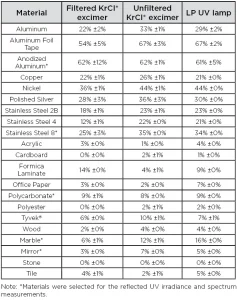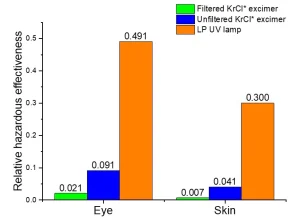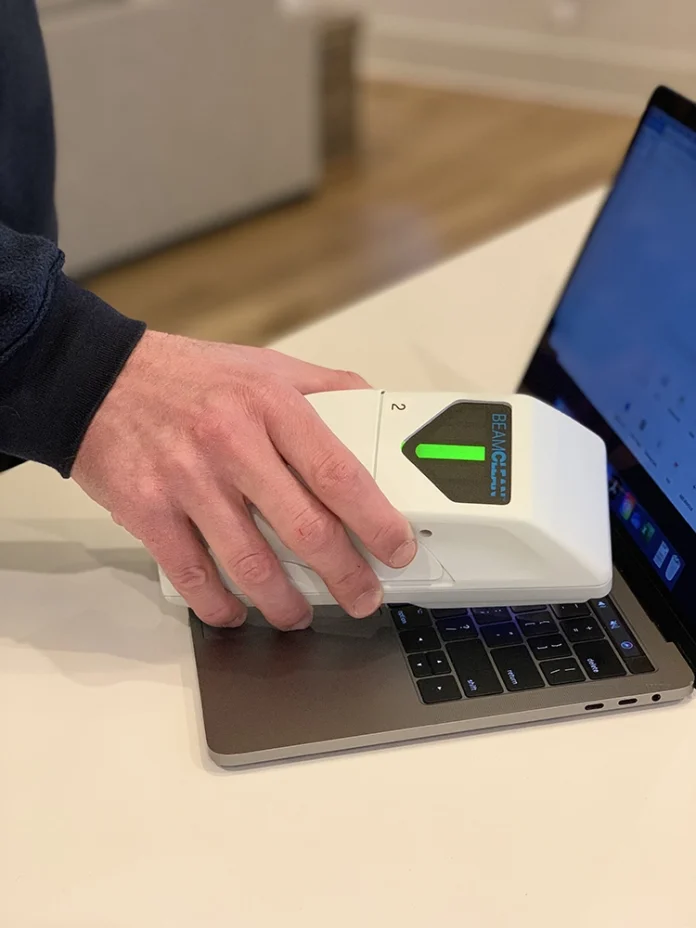By Ben Maa, Sam Burke-Bevisa, Luke Tiefela, Jennifer Rosenb, Ben Feeneyb and Karl G. Lindena
a. Department of Civil, Environmental and Architectural Engineering, University of Colorado Boulder, 4001 Discovery Dr., Boulder, CO 80303, United States
b. Freestyle Partners, LLC, and its affiliate, FSP Innovations, LLC, MI, United States
The COVID-19 pandemic has promoted interest in using UVC devices for surface disinfection to reduce pathogen transmission, especially in occupied public spaces. While UVC devices have been shown to be highly effective against various pathogens, safety of UVC devices needs to be evaluated before applying them around human occupants. Irradiation from conventional UVC devices, such as low-pressure (LP) mercury vapor lamps emitting at 254 nm, are known to be hazardous upon exposure to human skin and eyes, causing erythema and photokeratitis. 1-4 Although direct human exposure of UV irradiation from the UVC devices should be avoided during surface disinfection, reflected UV irradiation from surfaces may still pose health risks. As this reflectivity study has shown, Filtered Far UV-C in a handheld format when used as intended does not generate harmful amounts of reflected UV-C light to the user or people near the user, and is is safe for people to operate without protective gear for the skin or eyes. Compared to conventional UVC devices, emerging Far UVC devices emitting at 200 to 230 nm, like krypton chloride (KrCl*) excimer, could serve as a safer and better surface disinfection solution in occupied spaces, due to its minimal penetration into human cells. 5-7 Another health concern of UVC devices is that they may generate ozone via photochemical reaction and electric discharges, causing cough, throat irritation, and shortness of breath. 8
This study generated urgently needed data on UV reflection of common materials and guidance for assessment of the safety of UVC devices for surface disinfection in occupied spaces. UV reflection of 21 common materials was documented and compared using a filtered KrCl* excimer (installed with a bandpass filter at 222 nm), an unfiltered KrCl* excimer and a conventional low-pressure mercury vapor lamp. The safety of a Far UVC source, housed in a commercial hand-held surface disinfection device, was evaluated based on the irradiance and emission spectra of reflected UV irradiation, and ozone generation, measured at various locations around the device.

Table 1 shows the percent UV reflection (calculated as the fraction of reflected UV irradiance to the incident irradiance) from the surface of 21 common materials upon irradiation. All three tested UVC devices showed similar percentages of reflection from the surfaces, with the filtered KrCl* source exhibiting marginally lower reflection values compared to the unfiltered KrCl* excimer and the LP UV lamp. While most tested materials (20 out of 21 materials, except for stone) can reflect some level of UV irradiation, metals tended to exhibit higher reflection values than other materials, ranging from 12% to 67%, which agrees with previous studies. 9-11 For the same material, the UV reflection was modified by surface coating (aluminum vs. anodized aluminum) and polishing (stainless steels with different finishes).
The reflected UV irradiance and spectrum was measured by placing the UV devices at a distance of one inch from a surface, which is the recommended distance for surface disinfection application, according to the device manufacturer’s instructions. The average incident irradiance across an area two inches in radius from the center was 1.68 and 2.14 mW/cm² for the filtered and unfiltered KrCl* excimer devices, respectively. The reflected UV spectrum is the same as the device’s emission spectrum because the relative magnitude of UV reflection is consistent across UVC wavelengths. The reflective UV irradiance from five different materials (labeled in Table 1) was measured at various locations around the handheld UV devices. The reflective irradiance from different materials was ranked as: Anodized Aluminum > Stainless Steel #8 > Marble > Polycarbonate > Mirror, following the same rank of the material’s reflection values (Table 1). For the same material, the reflected intensity of UV irradiance was higher for the unfiltered KrCl* excimer than the filtered KrCl* excimer, mainly because of the higher UV irradiance from the unfiltered KrCl* excimer. The reflected UV irradiance decreased with the distance from the UV devices. The maximum reflected irradiance from different materials ranged from 2.1×10-4 to 1.2×10-2 mW/cm² for the filtered KrCl* excimer and 8.1×10-3 to 8.6×10-2 mW/cm² for the unfiltered KrCl* excimer.

The relative hazardous effectiveness (RE) for UV exposure of human eyes and skin was calculated for all tested UVC devices according to the American Conference of Governmental Industrial Hygienists (ACGIH®) threshold limit value (TLV) 12 (Figure 1). The filtered KrCl* excimer is much safer to be applied in occupied spaces, with RE that are 23.6 and 40.8 times lower than the LP UV lamp and 4.3 and 5.9 times lower than the unfiltered KrCl* excimer for eye and skin exposures, respectively. Combining the RE calculation and reflected UV irradiance measurements, these results suggest that the reflected UV irradiation for the filtered KrCl* excimer is unlikely to cause any adverse health risks. The daily maximum exposure time without any acute adverse health effect (Texp) is greater than 24 hours for most surfaces. Relatively long Texp (i.e., > 6 hours) also was observed when the unfiltered KrCl* excimer was applied to surfaces with low reflection value.
Limited ozone generation also was observed for the unfiltered and filtered KrCl* excimer. The maximum ozone concentration measured around the device over one minute of operation (i.e., the maximum time of continuous operation for the handheld surface disinfection devices per the manufacturer’s instructions) was less than three parts per billion (ppb), much lower than the FDA limit for extended exposure (i.e., 50 ppb).
In summary, this study provides needed data on UV reflection of commonly used materials and reports the relative safety of UVC devices for surface disinfection in occupied spaces, considering both the UV exposure to reflected irradiation and ozone generation. These results illustrate that the filtered KrCl* excimer handheld device is safe to be used as indicated in occupied spaces, with limited ozone generation and no health risk from reflected UV irradiation, even when applied on the most highly reflective surfaces.
The unfiltered KrCl* excimer still may be safe for disinfecting surfaces with low reflection values, but precautions need to be considered when applied to highly reflective surfaces for a longer period, such as wearing UV blocking goggles and covering exposed skin. More caution is needed for any use of the LP UV lamp due to its much greater hazardous effects and low TLV.
References
- Tenkate, T. D. Ultraviolet Radiation: Human Exposure and Health Risks. J. Environ. Health 1998, 61 (2), 9+.
- Zaffina, S.; Camisa, V.; Lembo, M.; Vinci, M. R.; Tucci, M. G.; Borra, M.; Napolitano, A.; Cannatã, V. Accidental Exposure to UV Radiation Produced by Germicidal Lamp: Case Report and Risk Assessment. Photochem. Photobiol. 2012, 88 (4), 1001–1004. https://doi.org/10.1111/j.1751-1097.2012.01151.x.
- Harrison, G. I.; Young, A. R. Ultraviolet Radiation-Induced Erythema in Human Skin. Methods 2002, 28 (1), 14–19. https://doi.org/10.1016/S1046-2023(02)00205-0.
Sengillo, J. D.; Kunkler, A. L.; Medert, C.; Fowler, B.; Shoji, M.; Pirakitikulr, N.; Patel, N.; Yannuzzi, N. A.; Verkade, A. J.; Miller, D.; Sliney, D. H.; Parel, J. M.; Amescua, G. UV-Photokeratitis Associated with Germicidal Lamps Purchased during the COVID-19 Pandemic. Ocul. Immunol. Inflamm. 2021, 29 (1), 76–80. - https://doi.org/10.1080/09273948.2020.1834587.
- Buonanno, M.; Welch, D.; Shuryak, I.; Brenner, D. J. Far-UVC Light (222 Nm) Efficiently and Safely Inactivates Airborne Human Coronaviruses. Sci. Rep. 2020, 10 (1), 1–8. https://doi.org/10.1038/s41598-020-67211-2.
- Buonannoa, M.; Ponnaiyaa, B.; Welcha, D.; Stanislauskasb, M.; Randers-Pehrsona, G.; Smilenova, L.; Lowyc, F. D.; Owensb, D. M.; Brennera, D. J. Germicidal Efficacy and Mammalian Skin Safety of 222-Nm UV Light. Radiat. Res. 2017, 187 (4), 483–481. https://doi.org/10.1667/RR0010CC.1.Germicidal.
- Kaidzu, S.; Sugihara, K.; Sasaki, M.; Nishiaki, A.; Ohashi, H.; Igarashi, T.; Tanito, M. Re-Evaluation of Rat Corneal Damage by Short-Wavelength UV Revealed Extremely Less Hazardous Property of Far-UV-C†. Photochem. Photobiol. 2021, 97 (3), 505–516. https://doi.org/10.1111/php.13419.
- Claus, H. Ozone Generation by Ultraviolet Lamps. Photochem. Photobiol. 2021, 97, 471–476. https://doi.org/10.1111/php.13391.
- Goncalves, A. Metallic Reflection. Eng. Libr. 2020, No. 2, 7–9.
- Claus, H.; Cooksey, C. Reflectance Measurements of Building Materials in the Far UVC (222 Nm) Wavelength Range. Proceeding SPIE 2022, 12201, 1220106. https://doi.org/10.1117/12.2633541.
- Blatchley, E. R. Numerical Modelling of UV Intensity: Application to Collimated-Beam Reactors and Continuous-Flow Systems. Water Res. 1997, 31 (9), 2205–2218. https://doi.org/10.1016/S0043-1354(97)82238-5.
- ACGIH. Threshold Limit Values (TLVs®) and Biological Exposure Indices (BEIs ®), 2022; The American Conference of Governmental Industrial Hygienists (ACGIH), 2022.






